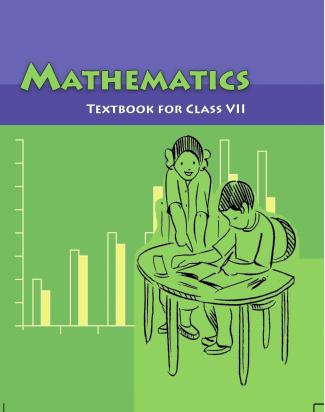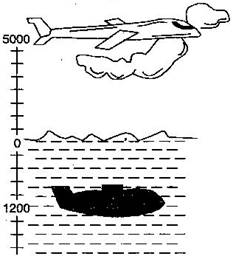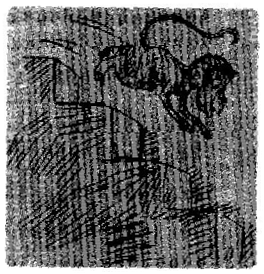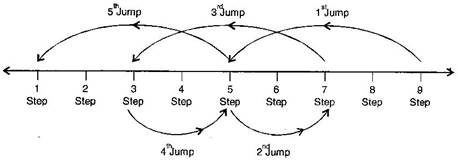
myCBSEguide App
Download the app to get CBSE Sample Papers 2025-26, NCERT Solutions (Revised), Most Important Questions, Previous Year Question Bank, Mock Tests, and Detailed Notes.
Install NowNCERT Solutions for Class 7 Maths Exercise 1.1 book solutions are available in PDF format for free download. These ncert book chapter wise questions and answers are very helpful for CBSE exam. CBSE recommends NCERT books and most of the questions in CBSE exam are asked from NCERT text books. Class 7 Maths chapter wise NCERT solution for Maths Book all the chapters can be downloaded from our website and myCBSEguide mobile app for free.
NCERT solutions for Class 7 Maths Download as PDF

NCERT Solutions for Class 7 Maths Integers
Class –VII Mathematics (Ex. 1.1)
Question 1.Following number line shows the temperature in degree Celsius {{}^\circ C} at different places on a particular day:

(a) Observe this number line and write the temperature of the places marked on it.
(b) What is the temperature difference between the hottest and the coldest places among the above?
(c) What is the temperature difference between Lahulspiti and Srinagar?
(d) Can we say temperature of Srinagar and Shimla taken together is less than the temperature at Shimla? Is it also less than the temperature at Srinagar?
Answer:
(a) The temperature of the places marked on it is:
| Places | Temperature |
| Bangalore | {\mathbf{2}}{{\mathbf{2}}^o}C |
| Ooty | {\mathbf{1}}{{\mathbf{3}}^o}C |
| Shimla | {{\mathbf{5}}^o}C |
| Srinagar | – {{\mathbf{2}}^o}C |
| Lahulspiti | – {{\mathbf{8}}^o}C |
(b) The temperature of the hottest place Bangalore = {\mathbf{2}}{{\mathbf{2}}^o}C
The temperature of the coldest place Lahulspiti = – {{\mathbf{8}}^o}C
Difference = {22^o}C{\text{ }}–{\text{ }}\left( {–{8^o}C} \right){\text{ }} = {\text{ }}{22^o}C{\text{ }} + {\text{ }}{8^o}C{\text{ }} = {\text{ }}{30^o}C
(c)The temperature of Srinagar = – {2^o}C
The temperature of Lahulspiti = – {{\mathbf{8}}^o}C
Difference = –{2^o}C{\text{ }} + {\text{ }}\left( {–{8^o}C} \right){\text{ }} = {\text{ }}–{2^o}C{\text{ }}–{8^o}C{\text{ }} = \;{6^o}C
(d)The temperature of Srinagar and Shimla = {5^o}C{\text{ }} + {\text{ }}\left( {–{2^o}C} \right){\text{ }} = {\text{ }}{5^o}C{\text{ }}–{2^o}C{\text{ }} = \;{3^o}C
The temperature at Shimla ={{\mathbf{5}}^o}C
Therefore, {3^o}C{\text{ }} < {\text{ }}{5^o}C
Thus, temperature of Srinagar and Shimla taken together is less than the temperature at Shimla.
Now, Temperature of Srinagar = – {{\mathbf{2}}^o}C
Therefore, {3^o}C{\text{ }} > {\text{ }}–{2^o}C
No, it is not less than the temperature at Srinagar.
Question 2.In a quiz, positive marks are given for correct answers and negative marks are given for incorrect answers. If jack’s scores in five successive rounds were 25, – 5, – 10,15and 10, what was his total at the end?
Answer:
Jack’s scores in five successive rounds are 25, – 5, – 10,15 and 10.
Total marks got by Jack = 25 + \left( { – 5} \right) + \left( { – 10} \right) + 15 + 10
= 25 – 15 + 25 = 35
Thus, 35 marks are got by Jack in a quiz.
NCERT Solutions for Class 7 Maths Exercise 1.1
Question 3.At Srinagar temperature was – 5^\circ C on Monday and then it dropped by 2^\circ C on Tuesday. What was the temperature of Srinagar on Tuesday? On Wednesday, it rose by 4^\circ C. What was the temperature on this day?
Answer:
On Monday, temperature at Srinagar = –{5^o}C
On Tuesday, temperature dropped = {2^o}C
\therefore Temperature on Tuesday = –{5^o}C{\text{ }}–{\text{ }}{2^o}C{\text{ }} = {\text{ }}–{7^o}C
On Wednesday, temperature rose up = {4^o}C
\therefore Temperature on Wednesday = –{7^o}C{\text{ }} + {\text{ }}{4^o}C{\text{ }} = {\text{ }}–{3^o}C
Thus, temperature on Tuesday and Wednesday was –{7^o}Cand –{3^o}Crespectively.
NCERT Solutions for Class 7 Maths Exercise 1.1
Question 4.A plane is flying at the height of 5000 m above the sea level. At a particular point, it is exactly above a submarine floating 1200 m below the sea level. What is the vertical distance between them?

Answer:
Height of a place above the sea level = 5000 m
Floating a submarine below the sea level = 1200 m
\therefore The vertical distance between the plane and the submarine = 5000 + 1200 = 6200 m
Thus, the vertical distance between the plane and the submarine is 6200 m.
NCERT Solutions for Class 7 Maths Exercise 1.1
Question 5. Mohan deposits Rs. 2,000 in his bank account and withdraws Rs. 1,642 from it, the next day. If withdrawal of amount from the account is represented by a negative integer, then how will you represent the amount deposited? Find the balance in Mohan’s accounts after the withdrawal?
Answer:
Deposit amount = Rs. 2,000 and Withdrawal amount = Rs. 1,642
\therefore Balance = 2,000 – 1,642 = Rs. 358
Thus, the balance in Mohan’s account after withdrawal is Rs. 358.
According to the number line, Rita moves towards east is represented by a positive integer. But she moves in opposite direction means Rita moves west, is represented by negative integer.
Distance from A to B = 20 km
Distance from B to C = 30 km
Distance from A to C = 20 – 30 = –10 km
Thus, Rital is at final position from A to C is –10 km.
NCERT Solutions for Class 7 Maths Exercise 1.1
Question 6.Rita goes 20 km towards east from a point A to the point B. From B, she moves 30 km towards west along the same road. If the distance towards east is represented by a positive integer then, how will you represent the distance travelled towards west? By which integer will you represent her final position from A?
Answer:
(i) Taking rows 5 + (–1) + (–4) = 5 – 5 = 0
(–5) + (–2) + 7 = –7 + 7 = 0
0 + 3 + (–3) = 3 – 3 = 0
Taking columns 5 + (–5) + 0 = 5 – 5 = 0
(–1) + (–2) + 3 = –3 + 3 = 0
(–4) + 7 + (–3) = 7 – 7 = 0
Taking diagonals 5 + (–2) + (–3) = 5 – 5 = 0
(–4) + (–2) + 0 = –6
This box is not a magic square because all the sums are not equal.
(ii) Taking rows 1 + (–10) + 0 = 1 – 10 = –9
(–4) + (–3) + (–2) = –7 – 2 = –9
(–6) + 4 + (–7) = –2 – 7 = –9
Taking columns 1 + (–4) + (–6) = 1 – 10 = –9
(–10) + (–3) + 4 = –13 + 4 = –9
0 + (–2) + (–7) = 0 – 9 = –9
Taking diagonals 1 + (–3) + (–7) = 1 – 10 = –9
0 + (–3) + (–6) = –9
This box is magic square because all the sums are equal.
NCERT Solutions for Class 7 Maths Exercise 1.1
Question 7.In a magic square each row, column and diagonal have the same sum. Check which of the following is a magic square.
(i)
| 5 | – 1 | – 4 |
| – 5 | – 2 | 7 |
| 0 | 3 | – 3 |
(ii)
| 1 | – 10 | 0 |
| – 4 | – 3 | – 2 |
| – 6 | 4 | – 7 |
Answer:
(i) Given: a = 21,b = 18
We have a – \left( { – b} \right) = a + b
Putting the values in L.H.S. = a – \left( { – b} \right) = 21 – \left( { – 18} \right) = 21 + 18 = 39
Putting the values in R.H.S. = a + b = 21 + 19 = 39
Since, L.H.S. = R.H.S Hence, verified.
(ii) Given: a = 118,b = 125
We have a – \left( { – b} \right) = a + b
Putting the values in L.H.S. = a – \left( { – b} \right) = 118 – \left( { – 125} \right) = 118 + 125 = 243
Putting the values in R.H.S. = a + b = 118 + 125 = 243
Since, L.H.S. = R.H.S Hence, verified.
(iii) Given: a = 75,b = 84
We have a – \left( { – b} \right) = a + b
Putting the values in L.H.S. = a – \left( { – b} \right) = 75 – \left( { – 84} \right) = 75 + 84 = 159
Putting the values in R.H.S. = a + b = 75 + 84 = 159
Since, L.H.S. = R.H.S Hence, verified.
(iv) Given: a = 28,b = 11
We have a – \left( { – b} \right) = a + b
Putting the values in L.H.S. = a – \left( { – b} \right) = 28 – \left( { – 11} \right) = 28 + 11 = 39
Putting the values in R.H.S. = a + b = 28 + 11 = 39
Since, L.H.S. = R.H.S Hence, verified.
NCERT Solutions for Class 7 Maths Exercise 1.1
Question 8.Verify a – \left( { – b} \right) = a + b for the following values of a and b:
(i) a = 21,b = 18
(ii) a = 118,b = 125
(iii) a = 75,b = 84
(iv) a = 28,b = 11
Answer:
(a) \left( { – 8} \right) + \left( { – 4} \right)\boxed{{\text{ }}}\left( { – 8} \right) – \left( { – 4} \right) \Rightarrow – 8 – 4\boxed{{\text{ }}} – 8 + 4
\Rightarrow – 12\boxed{{\text{ }}} – 4 \Rightarrow – 12\boxed{{\text{ < }}} – 4
(b) \left( { – 3} \right) + 7 – \left( {19} \right)\boxed{{\text{ }}}15 – 8 + \left( { – 9} \right) \Rightarrow – 3 + 7 – 19\boxed{{\text{ }}}15 – 8 – 9
\Rightarrow 4 – 19\boxed{{\text{ }}}15 – 17 \Rightarrow – 15\boxed{{\text{ }}} – 2
\Rightarrow – 15\boxed{{\text{ < }}} – 2
(c)23 – 41 + 11\boxed{{\text{ }}}23 – 41 – 11 \Rightarrow – 18 + 11\boxed{{\text{ }}}23 – 52
\Rightarrow – 7\boxed{{\text{ }}} – 29 \Rightarrow – 7\boxed{{\text{ > }}} – 29
(d)39 + \left( { – 24} \right) – \left( {15} \right)\boxed{{\text{ }}}36 + \left( { – 52} \right) – \left( { – 36} \right) \Rightarrow 39 – 24 – 15\boxed{{\text{ }}}36 – 52 + 36
\Rightarrow 39 – 39\boxed{{\text{ }}}72 – 52 \Rightarrow 0\boxed{{\text{ }}}20
\Rightarrow 0\boxed{{\text{ < }}}20
(e)\left( { – 231} \right) + 79 + 51\boxed{{\text{ }}}\left( { – 399} \right) + 159 + 81 \Rightarrow – 231 + 130\boxed{{\text{ }}} – 399 + 240
\Rightarrow – 101\boxed{{\text{ }}} – 159 \Rightarrow – 101\boxed{{\text{ > }}} – 159
NCERT Solutions for Class 7 Maths Exercise 1.1
Question 9.Use the sign of >, < or = in the box to make the statements true:
(a)\left( { – 8} \right) + \left( { – 4} \right)\boxed{{\text{ }}}\left( { – 8} \right) – \left( { – 4} \right)
(b)\left( { – 3} \right) + 7 – \left( {19} \right)\boxed{{\text{ }}}15 – 8 + \left( { – 9} \right)
(c)23 – 41 + 11\boxed{{\text{ }}}23 – 41 – 11
(d)39 + \left( { – 24} \right) – \left( {15} \right)\boxed{{\text{ }}}36 + \left( { – 52} \right) – \left( { – 36} \right)
(e)\left( { – 231} \right) + 79 + 51\boxed{{\text{ }}}\left( { – 399} \right) + 159 + 81
Answer:
NCERT Solutions for Class 7 Maths Exercise 1.1
Question 10.A water tank has steps inside it. A monkey is sitting on the topmost step (i.e., the first step). The water level is at the ninth step:

(i)He jumps 3 steps down and then jumps back 2 steps up. In how many jumps will he reach the water level?
(ii)After drinking water, he wants to go back. For this, he jumps 4 steps up and then jumps back 2 steps down in every move. In how many jumps will he reach back the top step?
(iii)If the number of steps moved down is represented by negative integers and the number of steps move up by positive integers, represent his moves in part (i) and (ii) by completing the following:
(a) – 3 + 2 – ………. = – 8
(b) 4 – 2 + …….. = 8
In (a) the sum \left( { – 8} \right) represent going down by eight steps. So, what will the sum 8 in (b) represent?
Answer:
(i) He jumps 3 steps down and jumps back 2 steps up. Following number ray shows the
jumps of monkey:

First jump = 1 + 3 = 4 steps Second jump = 4 – 2 = 2 steps
Third jump = 2 + 3 = 5 steps Fourth jump = 5 – 2 = 3 steps
Fifth jump = 3 + 3 = 6 steps Sixth jump = 6 – 2 = 4 steps
Seventh jump = 4 + 3 = 7 steps Eighth jump = 7 – 2 = 5 steps
Ninth jump = 5 + 3 = 8 steps Tenth jump = 8 – 2 = 6 steps
Eleventh jump = 6 + 3 = 9 steps
He will reach ninth steps in 11 jumps.
(ii) He jumps four steps and them jumps down 2 steps. Following number ray shows the
jumps of monkey:

Thus monkey reach back on the first step in fifth jump.
(iii) (a) – 3 + 2 – 3 + 2 – 3 + 2 – 3 + 2 – 3 + 2 – 3 + 2 – 3 + 2 – 3 + 2 = – 8
(b) 4 – 2 + 4 – 2 + 4 – 2 + 4 – 2 = 8
Thus, sum 8 in (b) represents going up by eight steps.
NCERT Solutions for Class 7 Maths Exercise 1.1
NCERT Solutions Class 7 Maths PDF (Download) Free from myCBSEguide app and myCBSEguide website. Ncert solution class 7 Maths includes text book solutions from Class 7 Maths Book . NCERT Solutions for CBSE Class 7 Maths have total 15 chapters. 7 Maths NCERT Solutions in PDF for free Download on our website. Ncert Maths class 7 solutions PDF and Maths ncert class 7 PDF solutions with latest modifications and as per the latest CBSE syllabus are only available in myCBSEguide.
CBSE app for Students
To download NCERT Solutions for Class 7 Maths, Social Science Computer Science, Home Science, Hindi English, Maths Science do check myCBSEguide app or website. myCBSEguide provides sample papers with solution, test papers for chapter-wise practice, NCERT solutions, NCERT Exemplar solutions, quick revision notes for ready reference, CBSE guess papers and CBSE important question papers. Sample Paper all are made available through the best app for CBSE students and myCBSEguide website.

Test Generator
Create question paper PDF and online tests with your own name & logo in minutes.
Create Now
Learn8 App
Practice unlimited questions for Entrance tests & government job exams at ₹99 only
Install Now